First Impression
As the owner of a Sony EX1-R, which has been my workhorse, I was reluctant to buy anything smaller. But the PXW-X70 is a little camera with a big heart. It has all the bells and whistles of the bigger more expensive PXW-X180. But, it is smaller and lighter, it has a 1” sensor and after an imminent firmware upgrade, it will be 4k operational.
The PXW-X70 is not a dressed up handy-cam, even though it looks like that fresh out of the box, with its handle off. The first thing you notice is its rugged feel and textured body. The handle gives it the extra weight it needs when panning and tilting. If you don’t look down at The PXW-X70, the size of the handle has you thinking this is a much bigger camera. Leave it off and you can use it like a handy-cam. But this is a chunky professional that has the muscle of a biggie.
One-chip vs three. I’ll tell you a story, without getting into too much detail, and you can decide. Multi Emmy award winning natural history producer and cameraman, David Parer, chose an old single chip Sony VX700 camcorder instead of the VX1000 three-chip, to shoot the Making of the Galapagos documentary. Our tests showed the single chip performed better in low light. Less chips to light, I guess. Which could be one of then advantages of this one chip camera.
Ergonomics
The well laid out controls remind me of the ergonomic changes Phillips made to the Betacam. Sony has actually thought about where the buttons should go on the PXW-X70. The large assignable button at the back of the handgrip is perfectly placed under the index finger when shooting with your hand in the grip. It also works when cradling the camera at waist height. Across the top of the grip the zoom rocker is easy to reach as is the assignable button in front of that – which is set as a one push auto iris control – cool. Each finger falls onto a function.
Now a professional video cameraman will ask, ‘does it have an SDI output?’ What they really mean is, ‘it’s a toy’, too small and dinky. It does have SDI and as far as being small, that’s all about perception – what you are used to. Put it on your shoulder and it’s missing six inches, dangle it hand held, and it’s almost perfectly balanced.
Small it might be but this camera asks to be held at shoulder height, with your hand through the grip, like its big brother. On the back of the camera there is a small joystick that ends up under your thumb (where it needs to be) enabling you to navigate camera menus without removing a hand. You can check focus, zoom, set exposure as you scroll through the menu system. There’s also SDI and HDMI plugs; a stop start button, DC in, an Auto or Manual switch and the ND filter wheel. Terrific!
The Lens and Zoom
Behind the stabilized 29 ml Zeiss lens sits a 1 inch 20 megapixel sensor that uses about 14 million pixels in video mode. Sony’s “clear image zoom” function works seamlessly with the 12x optical zoom to give you a 24x zoom range in HD.
If 24x is not enough use the digital extender to take the zoom up to 48x – excellent for that must get close breaking news type scenario.
The steady shot works well with three modes ‘Standard’ and ‘Active and ‘Off’. In ‘Active’ mode it tries to hold onto shots (a little) when panning or tilting. Switch it off when using a tripod and practice moving the camera without the steady shot on. Yes it takes a 1/4 screw, but this is a hand held camera!
Media and Codec
The pictures are recorded using either XAVC or AVCHD codec. The downside to having these new advanced formats is requiring faster, larger and thus more expensive cards. For XAVC you must use SDXC cards, preferably, but not essentially U3 cards, which come up to 512GBs. I use a standard card.
The two card slots can be set to record with manual switch over, or in switch mode where the camera flicks from slot A to slot B once A is full. You can also make two simultaneous recordings on both cards.
XAVC HD recordings are 10 bit 422 long GoP at 50Mb/s, 35Mb/s or 25Mb/s. The quality of the 50Mb/s recordings is amazing with no compression loss to my untrained eye. You can shoot at up to 60fps in 60i mode and 50fps in 50i mode. In 60i mode you also have 24fps. XAVC is a 264 codec that produces broadcast quality pictures at manageable sizes for most post workflow. The pictures really look like they come from a pro camera.
You’ll need to work out how you will transfer media. There are a few options and one is Brorsoft. If I only have one or two files to transfer I use Quicktime and then export, but Brorsoft works well for bulk transfers.
Low Light Test
We shot a low light test with the ND filter dialed in by mistake and on a 50 inch screen we could barely see noise. The codec is so good that you could quite comfortably shoot a stop under and then play with the image in post. Even in auto exposure mode, setting an offset in the menu, will allow you to do this.
This is a sensitive baby. At 9db it’s all clear and at -33db it’s as if you are wearing night vision glasses. If that’s not enough use the night shot mode that bypasses the IR filter and includes a switchable infra-red light, so you can shoot in darkness if required. This is an almost perfect camera for mojo work especially when using lights is a problem.
To see what you are shooting the PXW-X70 features a 3.5-inch type touch panel LCD panel (1.56 million dots, 16:9) that provides easy viewing in a wide range of lighting conditions. It also has a high-resolution 0.39-inch type OLED viewfinder (1.44 million dots, 4:3), which can be helpful when working in bright sunlight. But remember a mojo always keeps one eye open. The camera can be switched on and off by extending and retracting the screen or the viewfinder.
Image Aids
The PXW-X70 can be controlled either fully automatically or manually, as well as various in between modes. There is a switch on the back of the camera to toggle between full auto and manual. On the left side there are controls for the Iris, Gain and Shutter. Pressing one of these three buttons chooses that function which can them be set by the wheel just below the lens.
The camera has picture profiles so if you want you can soften or sharpen images. As well as detail and aperture controls there are also controls for gamma and color. The color controls adjust saturation as well as R, G, B etc. In addition there is a choice of 6 different preset color modes including black and white.
There is another button for white balance control on the side of the camera with the usual presets plus auto white balance. Just under the Manual/Auto switch there is a selector for the built in ND filters. I own a GH4 and as great as this camera is I’m always searching for ND filters, especially when playing with depth of field and shooting in high contrast situations.
The PXW-X70 has one large control ring that can be used to focus the lens, or to act as a manual zoom ring, by toggling a switch behind the ring. The ring has a very professional texture that makes it easy to use when fine-tuning.
Audio
On the top of the PXW-X70 is Sony’s new MI shoe (Multi-Interface) for connecting accessories like the supplied handle with XLR audio inputs. The supplied detachable handle is both well made and large enough that you almost think your holding a bigger camera. Be aware that when the handle is attached it activates the XLR audio inputs and if you want to use the internal mic you’ll need to go into settings and choose it. On further testing we found that the shotgun mount has a large diameter and will require a filler pad for most shotgun mics (we tried three), which are narrower than Sony video shotguns. I don’t get this and will keep you updated on this conundrum. The mount on my camera moves around a lot. Will it create unwanted noise. I’ll speak with Sony and get back to you.
We tested the Sony UWPD11 (CE42) radio microphones with the this camera and the set up worked a treat (UWPD11 review coming soon).
Connectivity and remote control
The camera has WiFi and NFC and allows remote control via Content Browser Mobile app and . enables pairing with an NFC tablet or smartphone simply by touching the device against the side of the camera. Streaming and file transfer will become available with a future firmware update. The Content Browser Mobile smartphone app can be downloaded from the Google Play Store or Apple App Store. It enables you to record and activate a number of other functions.
UnBoxed
Here’s a video as the PXW-X70 came out of the box. Full video review to come.
Wrap Up
This is a cool camera. Excellent in low light. Heaps of professional features. It enables you to play with highlights, gamma, colour and exposure. The large sensor, together with the switchable built in ND filters, gives a much greater control over the depth of field than you’d expect in a small camera. It’s obvious that this is a great second camera, something roving PAs or APs can use. But with all the features and shooting at 50Mb/s it’s a perfect replacement for the camera in your VJ or mojo kit . We’ve been using much lesser cameras to produce prime time broadcast television for years. Of course you can get picky about how it treats highlights, its size and weight, the screen housing, which may prove flimsy, and the wobbly and large diameter (don’t get it) shotgun mount. But in over 30 years of producing broadcast TV content, including shooting thousands of hours of fly on the wall content and high end current affairs, I believe this is the best camera of its type I have ever used. By a country mile!
Specifications
| General | |
|---|---|
| Mass | Approx. 900 g (1 lb 15 oz) (body) Approx. 1400 g (3lb 1oz) (with lens hood, XLR handle unit, eyecup, NP-FV70 battery) |
| Battery Operating Time | Approx. 120 min. with NP-FV70 battery (while recording with LCD, XAVC 1080/60i, 50Mbps) Approx. 200 min. with NP-FV70 battery (while playing with LCD, XAVC 1080/60i, 50Mbps) |
| Recording Format (Video) | XAVC HD : MPEG-4 AVC/H.264 4:2:2 Long profile AVCHD : MPEG-4 AVC/H.264 AVCHD 2.0 format compatible DV |
| Recording Format (Audio) | XAVC HD (1920 x 1080)@59.94p, 50p, 50Mbps/35Mbps XAVC HD (1920 x 1080)@59.94i, 50i, 50Mbps/35Mbps/25Mbps XAVC HD (1920 x 1080)@29.97p, 25p, 23.98p, 50Mbps/35Mbps XAVC HD (1280 x 720)@59.94p, 50p,50Mbps AVCHD (1920 x 1080)@59.94p, 50p,PS mode (28Mbps) AVCHD (1920 x 1080) @59.94i/50i/29.97p/25p/23.98p, FX mode (24Mbps), FH mode (17Mbps) AVCHD (1280 x 720)@59.94p, 50p, FX mode (24Mbps), FH mode (17Mbps), HQ mode (9Mbps) DV (720 x 480) @59.94i, 25Mbps DV (720 x 576) @50i, 25Mbps 130.3 x 180.9 x 287 mm (5 1/4 x 7 1/8 x 11 3/8 inches) (With the accessories (lens hood, large eyecup, XLR handle unit) , excluding the grip belt and including the projecting parts) |
| Recording/Playback Time | XAVC HD@LPCM 2ch 50Mbps Approx. 120 min with 64 GB memory card XAVC HD@LPCM 2ch 35Mbps Approx. 170 min with 64 GB memory card XAVC HD@LPCM 2ch 25Mbps Approx. 220 min with 64 GB memory card AVCHD@LPCM 2ch PS Mode Approx. 290 min with 64 GB memory card Approx. 145 min with 32 GB memory card AVCHD@LPCM 2ch FX Mode Approx. 340 min with 64 GB memory card Approx. 170 min with 32 GB memory card AVCHD@LPCM 2ch FH Mode Approx. 450 min with 64 GB memory card Approx. 225 min with 32 GB memory card DV Approx. 280 min with 64 GB memory card Approx. 140 min with 32 GB memory card |
| Camera Section | |
| Imaging Device (Type) | 1.0-type (13.2 mm x 8.8 mm) back-illuminated Exmor R CMOS sensor |
| Effective Picture Elements | Approx.14.2M pixels (16:9)/Approx.10.6M pixels (4:3) |
| Built-in Optical Filters | OFF: Clear, 1: 1/4ND, 2: 1/16ND, 3: 1/64ND |
| Shutter Speed | 60i]*2 : 1/8 - 1/10,000 (1/6 - 1/10,000 when shooting with 24p) [50i]*3 : 1/6 -1/10,000 |
| Slow & Quick Motion Function | [60i]*2 :1080p: Frame rate selectable 1.2.4.8.15.30, 60 fps [50i]*3 : 1080p: Frame rate selectable 1.2.3.6.12.25, 50 fps |
| White Balance | Preset (Indoor:3200K, Outdoor:5600K±7 steps, Color temparature set range: 2300-15000K) Onepush A, B, Auto selectable |
| Gain | -3, 0, 3, 6, 9, 12,15, 18, 21, 24, 27, 30, 33 dB, AGC |
| Input/Output | |
| Audio Input | XLR-type 3-pin (female) (x2), line/mic/mic +48 V selectable |
| Video Output | Integrated into Multi/Micro USB jack (×1), Composite 1.0Vp-p, 75Ω |
| SDI Output | BNC (x1), 3G/HD/SD SMPTE 424M/292M/259M standards |
| USB | Multi/Micro USB jack (x1) |
| Headphone Output | Stereo mini jack (x1) |
| HDMI Output | Type A (x1) |
| Monitoring | |
| Viewfinder | 1.0 cm (0.39 type) OLED Approx. 1.44M dots |
| LCD | 8.8 cm (3.5 type) Approx. 1.56M dots. |
| Built-in Microphone | |
| Built-in Microphone | Omni-directional stereo electret condenser microphone. |
| Media | |
| Type | Memory Stick Pro Duo™ and SD/SDHC/SDXC compatible x1, SD/SDHC/SDXC x1 |
| Wi-Fi/NFC | |
| Supported format | IEEE 802.11 b/g/n |
| Security | WEP/WPA-PSK/WPA2-PSK |
| NFC | NFC Forum Type 3 Tag compliant |
| Supplied Accessories | |
| Supplied Accessories | XLR handle unit (1), Lens hood (1), Lens cap (1), Large eyecup (1), Accessory shoe kit (1), USB cable (1) Rechargeable battery pack (NP-FV70) (1), AC Adaptor (AC-L200D) (1), Power cord (mains lead) (1) Wireless Remote Commander (RMT-845) (1), Lithium battery (CR2025 for the Wireless Remote Commander (1), Pre-installed to the Wireless Remote Commander, Operating Guide (2), CD-ROM “Manuals for Solid-State Memory Camcorder” (1), Warranty (1) |
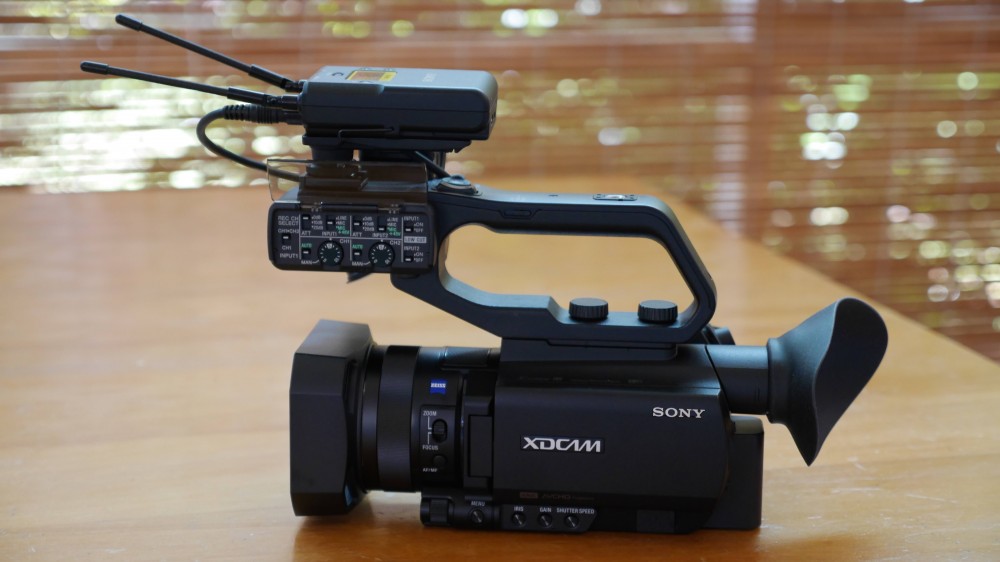

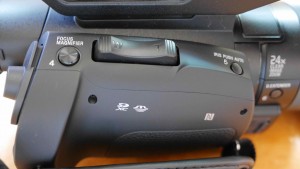
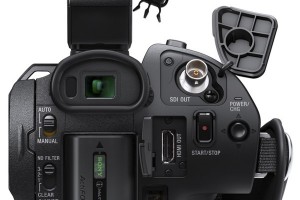

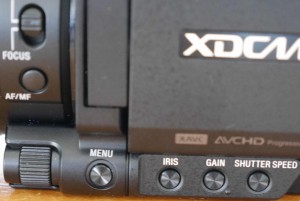
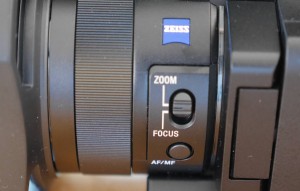
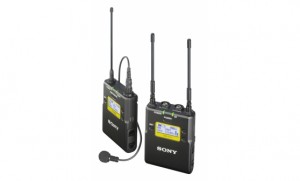
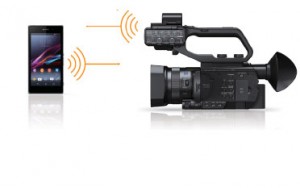
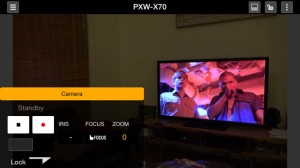
Hi Thanks, great review and video!
Just wondering, you said the mic holder has rubber nodes to fit different sized mics? I’m thinking of getting a Senheisser MKE600 for mine but was worried that it was two thin for the holder. With the rubber nodes you mentioned would it still be the case?
Hi – sorry for the lag in response. I haven’t used the 600 so not sure of the size. Let m know how you go.
The MKE600 diameter is smaller than the rubber nodes, so you will need some sort of filler. I used thin sheets of rolled foam and it works fine.
What did you use as “filler pads” to fit a smaller diameter shotgun mic in the holder?
My mics fit with the rubber nodes acting as pads. Otherwise you could use rolled foam, which I have used in my X1R.